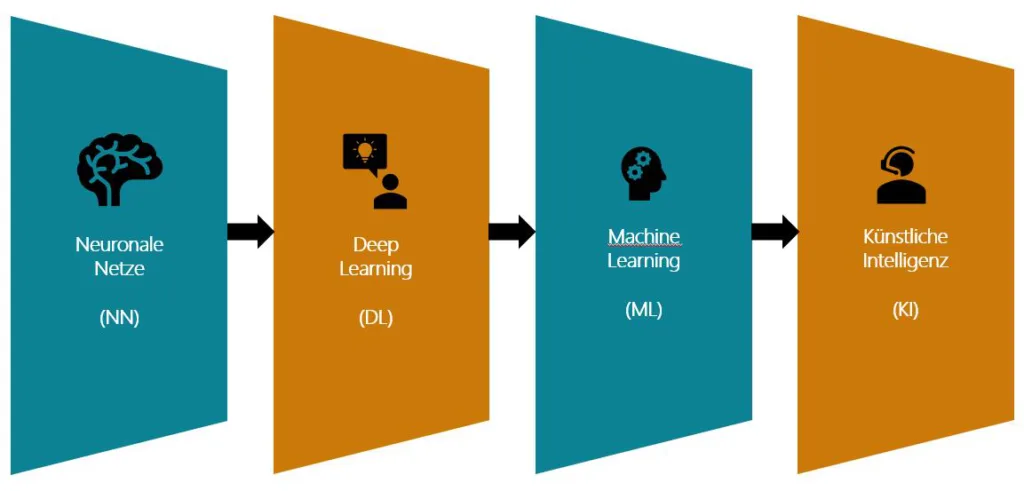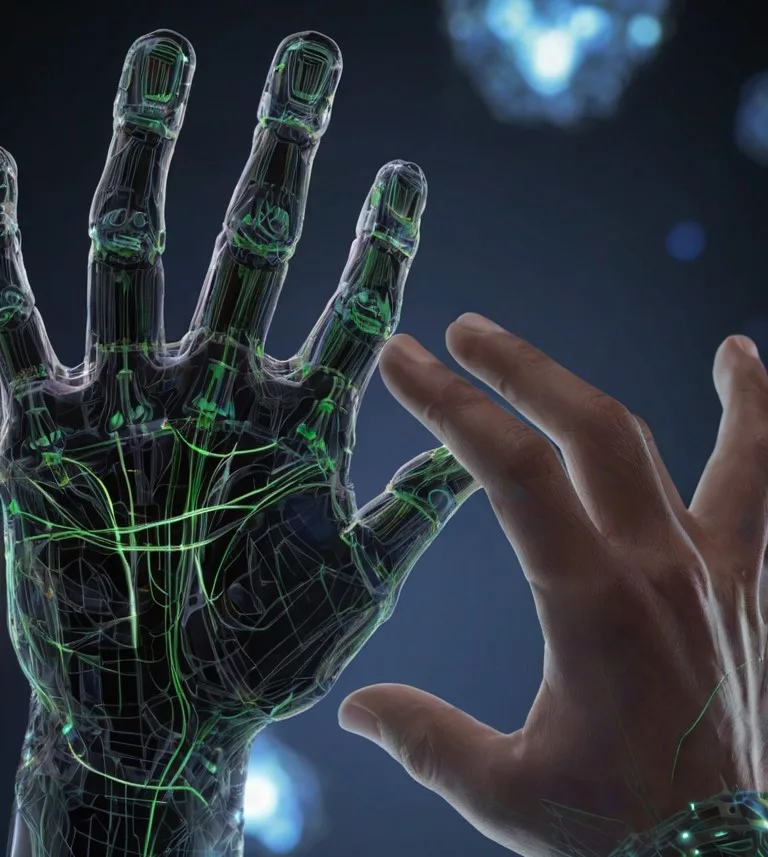AI? What is that? ai basics
Here is the audio version and the contribution on Youtube
The ultimate guide to artificial intelligence for beginners
Welcome to the world of artificial intelligence,
In this article, I will show you what this word AI, which is currently on everyone’s lips, actually means. And you don’t need to take a course to do this. It’s just about understanding the basics of AI.
My aim is to provide you with an understandable introduction to the basics of artificial intelligence as a guide for beginners using examples and insights.
I will provide an overview and then go into more detail in the following posts.
Basics of AI | AI for beginners
What exactly is artificial intelligence?
It is a computer science technology designed to solve tasks that normally require human intelligence and judgment. In addition, it should be able to learn from its experience, i.e. solved tasks . These are the basic concepts.
Good examples of AI applications are image processing, speech recognition and interaction as well as solving tasks based on your own knowledge.
The two types of AI
We currently divide them into 2 basic types
The strong AI
The strong AI is still under development at the moment.
It is not given any predefined tasks. It is designed to independently recognize and avoid dangerous situations, for example. It also acts alone in situations that normally require human intelligence.
Its target area is a completely autonomous search and solution of tasks, which is why ethical questions must also be asked during use. Humans must then evaluate it in supervised use, check its trustworthiness and impose clear rules on it.
This larger version, which can act independently without a command, is to be used in the field of autonomous driving, for example.
The weak AI
This variant is the one that we can currently use in more and more areas of application. Its primary function is to provide support. Be it in the private sphere (e.g. as voice assistants) or in the professional sphere (automation or data provision).
The important difference here is that artificial intelligence is used on human command.
The models improve with every task and continue to learn.
But every step requires a human task, a human command.
People must lead the way.
In the same way, the technology is only active if it has a predefined set of rules based on its model.
The two categories of AI
Artificial intelligence is also divided into two different categories, but these often overlap in the models. It is therefore up to you to understand the difference between the two approaches.
Predictive AI
Predictive AI uses historical data to predict future events or trends.
It uses machine learning and statistical models to recognize patterns in the data and make predictions.
For example, it can be used in medicine for diagnostics, in vehicle fleet management for maintenance requirements or in finance for credit risk assessment.
Generative AI
Generative AI, on the other hand, generates new data or content that is human-like or can be used by us.
Their area of responsibility is, for example, the creation of images, music and videos or simulation in training and research.
How does artificial intelligence work?
It consists of its training database, algorithms, models and various techniques.
You have to imagine the whole thing in the form of a row:
- The technology receives a training database with a wide variety of data such as websites, images, texts, figures or other relevant information
- By using algorithms, the system analyzes the data and creates models that can perform certain tasks in the areas of application described.
- The created model learns during the training. It should recognize correlations, patterns and structures in large amounts of data and convert these into general rules for itself.
- After training, the finished model can then process queries by applying the learned patterns to new data and tasks and providing the results.
Practically in the same way that we humans consult our experience when we see something new.
We compare this new discovery with something we know or have learned from the past.
The model also creates correlations from existing knowledge to generate answers or predictions and acquires new knowledge through experience.
The first 3 important terms in connection with AI for beginners
Neural Networks (NN)
Artificial neural networks are the human-like models used in deep learning AI.
They are modeled on the structure of the human brain and consist of several layers.
There are 3 layers worth knowing here.
There is the input layer, which receives incoming data.
Then the hidden layer. Data processing and pattern recognition take place in this layer.
The third layer is the output layer, which then outputs the finished data and solutions.
The NNs are therefore the virtual basis and home of the technology. (1)
Deep Learning (DL)
DL is a subdivided area of ML. It enables the recognition of patterns and correlations in large amounts of data.
For example, it can recognize images by comparing them with others. Another area of application is to recognize a certain language and translate it into another. (2)
Machine Learning (ML)
ML is the technology that performs the top step in our series. It develops the algorithms and the models that are then trained with the data. It is the technology that constructs the models.
At the same time, it also has the fundamental understanding on the basis of which it constructs models.
The basic understanding is, for example, the ability to interact, that the ML knows human language, understands it and can respond to it.
ChatGPT is a practical example of this.
It is a technology with which you can communicate normally as a human being.
As the name suggests: just chat away. You can write to her or talk to her verbally.
It also has voice recognition and voice output. (3)
These parts are then combined to create artificial intelligence technology.
Here is a simple representation of the hierarchy:

Of course, this is just a simplified representation of the technology so that you can see the connection. The systems themselves are complex and have many more and very specific sub-areas.
The systems are also being developed further. Research is being carried out. The technology is developing itself. We can look forward to seeing what the technology will look like in the future.
You can also create your own model and provide it with your own training data. This allows you to create your own AI for a specific purpose or task. Complex models can be programmed in Python, for example.
But in general, you don’t need any prior knowledge of programming or data engineering.
Why are there so many different AI tools?
Since the release of ChatGPT, we’ve seen new offerings and great innovations in AI every day.
I think you are asking yourself the question in this context.
If ChatGPT can answer the questions, why do I need other apps?
The application will continue to develop on its own, following the path of machine learning and artificial intelligence as a whole.
The diversity has the following reasons
First of all, of course, economic reasons.
Every large company wants its own version that is adapted to its philosophy, its customers and its own needs.
For example, your own solution can use personal information. If the customer then asks to find out more details about the product, the technology can answer them.
It helps him to improve the shopping experience.
The second reason is pure size.
The software needs large amounts of data for training and as a basis for your work. This data must be stored and protected. And the decentralized way in several locations is always better than the centralized way in a comprehensive app.
The consequence of this is also the third reason
Because the amount of data, the transfer to the user and the performance are limited, we have specialized tools that can perform tasks in certain areas. This software is aimed specifically at its target group.
From the world of generative AI, we can mention text generation.
In other words, the ability to create texts on the basis of certain specifications and specific training knowledge. A generative AI that creates texts is clearly superior in this application and challenge to another that creates images. The same applies the other way around, of course.
Just as we humans have special skills and talents, we create apps that can work with us in our field. Therefore, AI will certainly occur in areas in the future that we cannot yet imagine.

How do I get started with artificial intelligence as a beginner?
My tried and tested tip: start simple.
Simply ignore the flood of offers from different tools and go for the large, simple models.
Go back to the beginning of the history of AI in a figurative sense.
Take one of the big AI models of your choice. For example ChatGPT, Gemini, Llama or another.
This technology is usually free of charge for simple use.
It doesn’t matter which AI you start with.
It is just as unimportant what you start with. Whether you use your cell phone, tablet or computer.
It’s not important how you get started. It’s important to make a start!
Just get started and see the application as your virtual and technical assistant.
You will learn the basics and areas of application in direct interaction.
Discuss everyday issues and situations with her. Even if it’s the weather. Just ask what interests you.
At this point, it is only important that you find an approach to how you can use artificial intelligence.
The tool already has the answer to so many simple questions.
For example, if you have a problem with a website when your cell phone isn’t working properly, you’ve been looking for a function somewhere. Just ask.
There are certain assumptions that AI will take over simple Googling, for example. I myself have clearly noticed the effects of AI. Since I started using it for myself, I hardly google in the traditional way anymore.
I started by asking simple support questions and talking to the AI about restaurants and sports.
For example, I’m currently writing this post in Google Docs. I’m so engrossed in writing that I simply can’t find a function I need in Docs. I go to the AI and ask it where it is and it tells me. Topic done and move on.
By using artificial intelligence, you can google much more precisely, so to speak, because the AI understands what you want to know. In the context and the language you use.
Whether in writing or by voice. You can tell her what you want to know via voice chat and save time searching and navigating.
What can I already use AI for in everyday life as a beginner?
I will only go into this point briefly. This first article is only intended to pick you up from 0 on the subject of artificial intelligence for beginners.
There are many possible applications for using the model in your private life right now. The same goes for your professional life, even if your employer is still in the early stages of developing an AI strategy.
Here are a few examples, but the basic attitude is what counts.
Make AI your ally! Because then you have an advantage
In a purely professional context, it will help you to do what you do much more quickly and easily. Over time, this will extend to every area of work.
For example, if you work in processing. At some point, Automation will take all the hard and strenuous work off your hands and you will control the process and the products.
In the case of a computer task, you can say that it takes over the data transfer between the programs, pre-sorts the emails, does your filing and more.
If you work in advertising, generative AI can help you create images or text.
The areas of application are almost unlimited.
Artificial intelligence is already finding its way into the private sphere and this area is set to expand. To give you a few simple examples here too.
An assistant who coordinates your appointments and reminds you of doctor’s appointments. Who searches for important information for you from data records.
Travel providers are currently testing AIs that will provide you with precisely tailored vacation offers based on your previous trips and your wishes.
While we’re on the very topical subject of vacations. An application that collects your vacation photos, merges them into videos or corrects optical blunders and camera shake.
Here, too, there will be more offers and many more options.

A brief ABC of artificial intelligence
Finally, a few small terms for your understanding:
Chatbot
Simply put, the chatbot is a mini AI that has been placed at a specific point for a specific purpose.
For example, to guide you as a customer through a website, answer questions about products or record messages.
In the general application, it is a small companion to simplify the customer experience. Some also notify you when you pause the order process in the store.
In addition to this function, there are many other applications for the little companions.
Hallucinations
If you take a closer look at the function, you will always notice limitations of liability, so-called disclaimers. The unanimous text states that you should not completely trust the answers and should always check them again.
The reason for these texts includes hallucinations. This term is used, for example, to describe false facts and nonsensical details.
You have to understand that such a model has no connection or access to the real world.
It is not possible for technology to experience a situation in reality. It can therefore only refer to its data, for example on the basis of case studies. Like children, they learn the basics of the world but without reference to it.
But we all know that describing a situation is different from experiencing it.
It is also possible that the specific query does not match the training data. That there are no texts and multiple-choice questions on these topics, something was incorrectly transferred to an incorrect pattern or other reasons.
In my opinion, hallucinations show us the limits of technology, which we should not ignore even with enthusiasm.
Natural Language Processing (NLP)
NLP is an element of language interaction and the ability to first understand the language spoken by people. At the same time, to reproduce it in such a way that the person feels comfortable in the communication.
Simply put, it is intended to imitate natural speech and the speech process of humans. (4)
Prompting
A word that sounds strange to us German speakers, but describes a process that we do again and again when dealing with technology.
A request that you send to a tool is a prompt. Whether written or verbal.
You can imagine that prompting is a very important factor when dealing with the new systems. That is why it is constantly being refined and improved among insiders.
You want to pursue a specific purpose with your request.
To achieve this, it is important that the AI knows exactly what you need.
The most important word in this context is context.
Explain to her exactly what you are looking for and under what circumstances. The better you describe the situation, the better your result will be in the end. (5)
I hope I have been able to give you a better understanding of artificial intelligence, language models and principles with this introduction to the world.
Over time, you will find your own best practices, your own portfolio and your own ultimate guide through this new world.
Your opinion is needed!
I hope you enjoyed this article. I’m planning more on interesting AI topics. Please let me know what you think. What interests you? What would you like to read in another article?
Thank you for your feedback!
Best regards
Florian
PS: This text has not been generated. I have written it from my own experience.
Have a look and follow me
My social media presence and interesting facts about me

References
(1) The neural network on Wikipedia
(3) Wikipedia machine learning
